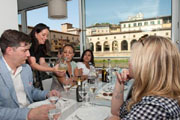-
(单词翻译:双击或拖选)
US Tourists Treated to True Taste of Tuscany
Antoinette Mazzaglia knows where to find all of the best food in her adopted city of Florence, Italy, and she's helping1 fellow Americans find it.
After hearing repeated tourist complaints about the local cuisine2, the food and wine expert launched Taste Florence four years ago, to give tourists a true taste of the Tuscan capital.
The petite woman with flowing black hair and high-heeled sandals stands on a church’s steps, looking more Italian than Sophia Loren. She hands out an Italian breakfast staple3 - cornetti - pastries4 filled with custard - to a half-dozen Americans. As they nibble5, Mazzaglia, Toni for short, introduces herself.
“Basically, all my great-grandparents were born all over Italy, mostly in the South. And so I like to say that I’m 100 percent Italian. I was just assembled in America. Kind of like a Volkswagen, actually like a Fiat6 now.”
She’s been parked in Florence for about a decade. The University of North Carolina graduate spent a semester abroad here, studying Italian culture and cuisine. She fell in love with a Tuscan man and decided7 to return. But she soon realized that her amore for Florence’s food was stronger than for the fellow.
Good taste
 |
| Antoinette Mazzaglia, of Taste Florence, shows tourists how to read a wine label at the Golden View Open Bar overlooking Florence’s Ponte Vecchio. |
Mazzaglia launched Taste Florence with a simple goal.
“For visitors, when they come to the city to not go away with a bad taste in their mouth.”
She says tourists often fall into a bad-food trap after a long day of museum-hopping.
“They’re starving and they get a really bad sandwich in one of those little tourist trap places that has everything," she says. "If a place has panini, gelato, waffles and pizza - there’s a place like that right near the Uffizi - it’s probably going to be really bad. Because if you have time to make all that, you really didn’t make it yourself.”
Mazzaglia has to start from scratch in describing Tuscan cuisine, particularly to Americans who imagine they’ll be eating pizza and spaghetti. The bilingual Mazzaglia offers guided visits of markets and specialty8 shops.
Her clients see and savor9 this so-called “poor man’s food” based on beans, vegetables and wild game. Today, a group of six Americans has already sampled Tuscan cheeses, meats, oils. Next up: gelato.
Pennie DiMartino digs in. “It almost tastes like liquor. Like if you put rum on ice cream. But better. It doesn’t have a liquor aftertaste."
The Long Islander came to Italy to eat the Italian food that her half-Italian husband doesn’t know how to make. She and the others dine on spelt salad, stuffed zucchini and are encouraged to try salted cod10 on Friday.
Learning curve
Frequent traveler William Moore says Mazzaglia has helped them sink their teeth into Florence’s and Italy’s true art - cuisine.
“You may not be able to appreciate every detail in every work of art at the Uffizi but you surely can appreciate a fantastic carbonara or what have you. We all come equipped with basic equipment - the taste buds for that. You don’t need a degree in art history to see the sort of subtle layers of this dish versus11 that."
Mazzaglia's clients won’t get duped when selecting wines for dinner or gifts. They’ll also make sure their extra virgin12 olive oil isn’t more than a year old and won’t judge it by its color. Italians learn these lessons as children; Americans need a guide to this varied13 culinary culture.
However, according to Mazzaglia, Americans are becoming more familiar with Italian cuisine thanks to cooking shows on television.
“Now we're starting to watch the Food Network and other fantastic networks that are giving us a wealth of chefs and programs where they travel to Italy, to all parts of Italy, and helping people understand there is a difference," Mazzaglia says. "Each region has its own food, each town has its own food. Even across town in Florence, you have two different plates."
With each glass, it becomes clearer Mazzaglia has shown these Americans how to eat and drink like Italians. They linger over the Tuscan reds and nibble on tomato-topped bruschette. Strangers this morning exchange email addresses and promise to keep in touch.
On this day, Taste Florence has taught them what Italians have known for centuries - that the time you spend eating is never wasted.
 收听单词发音
收听单词发音
1
helping

|
|
| n.食物的一份&adj.帮助人的,辅助的 | |
参考例句: |
|
|
|
2
cuisine

|
|
| n.烹调,烹饪法 | |
参考例句: |
|
|
|
3
staple

|
|
| n.主要产物,常用品,主要要素,原料,订书钉,钩环;adj.主要的,重要的;vt.分类 | |
参考例句: |
|
|
|
4
pastries

|
|
| n.面粉制的糕点 | |
参考例句: |
|
|
|
5
nibble

|
|
| n.轻咬,啃;v.一点点地咬,慢慢啃,吹毛求疵 | |
参考例句: |
|
|
|
6
fiat

|
|
| n.命令,法令,批准;vt.批准,颁布 | |
参考例句: |
|
|
|
7
decided

|
|
| adj.决定了的,坚决的;明显的,明确的 | |
参考例句: |
|
|
|
8
specialty

|
|
| n.(speciality)特性,特质;专业,专长 | |
参考例句: |
|
|
|
9
savor

|
|
| vt.品尝,欣赏;n.味道,风味;情趣,趣味 | |
参考例句: |
|
|
|
10
cod

|
|
| n.鳕鱼;v.愚弄;哄骗 | |
参考例句: |
|
|
|
11
versus

|
|
| prep.以…为对手,对;与…相比之下 | |
参考例句: |
|
|
|
12
virgin

|
|
| n.处女,未婚女子;adj.未经使用的;未经开发的 | |
参考例句: |
|
|
|
13
varied

|
|
| adj.多样的,多变化的 | |
参考例句: |
|
|
|















